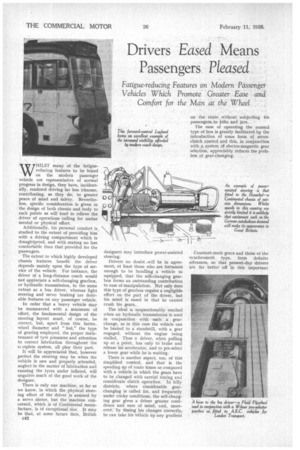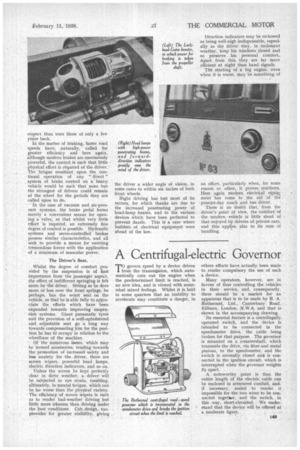Drivers Eased Means Passengers Pleased Fatigue-reducing Features on Modern Passenger
Page 92

Page 93

If you've noticed an error in this article please click here to report it so we can fix it.
Vehicles Which Promote Greater Ease and Comfort for the Man at the Wheel WHILST many of the fatiguereducing features to be found on the modern passenger vehicle are representative of normal progress in design, they have, incidentally, rendered driving far less irksome, contributing, as they do, to greater peace of mind and safety. Nevertheless, specific consideration is given in the design of both chassis and body to such points as will tend to relieve the driver of operations calling for undue mental or physical effort.
Additionally, his personal comfort is, studied to the extent of providing him with a driving compartment which is draughtproof, and with seating no less comfortable than that provided for the passengers.
The extent to which highly developed chassis features benefit the driver depends mainly upon the type of service of the vehicle. For instance, the driver of a long-distance coach would not appreciate a self-changing gearbox, or hydraulic transmission, to the same extent as a bus driver, whereas light steering and servo braking are desirable features on any passenger vehicle.
In order that a heavy vehicle may be manceuvred with a minimum of effort, the fundamental design of the steering layout must, of course, be correct, but, apart from this factor, wheel diameter and " feel," the type of gearing employed, the proper maintenance of tyre pressures and attention to correct lubrication throughout the cc inplete system, all play their part.
It will be appreciated that, however perfect the steering may be when the vehicle is new and properly attended, neglect in the matter of lubrication and running the tyres under inflated, will negative much of the good work of the designer.
There is only one machine, so far as we know, in which the physical steering effort of the driver is assisted by a servo niotor, but the machine concerned, which is of Continental manufacture, is of exceptional size. It may be that, at some future date, British 612 designers may introduce power-assisted steering.
Drivers no doubt mill be in agreement, at least those who are fortunate enough to be handling a vehicle so equipped, that the self-changing gearbox forms an outstanding contribution to ease of manipulation. Not only does this type of gearbox require a negligible effort on the part of the driver, but his mind is eased in that he cannot crash his gears.
The ideal is unquestionably reached when an hydraulic transmission is used in conjunction with such a gearchange, as in this case the vehicle can be braked to a standstill, with a gear engaged, without the engine being stalled. Thus a driver, when pulling up at a point, has only to brake and release his accelerator, and to pre-select a lower gear while he is waiting.'
There is another aspect, too, of this simplified control, and that is the speeding up of route times as compared with a vehicle in which the gears have to be changed with careful timing and considerate clutch operation. In hilly districts, where considerable gearchanging is called for, and frequently under tricky conditions, the self-changing gear gives a driver greater confidence and ease of mind, and, moreover, by timing his changes correctly, he can take his vehicle up any gradient respect than were those of only a few years back.
In the matter of braking, faster road speeds have, naturally, called for greater efficiency and here again, although modern brakes are enormously powerful, the control is such that little physical effort is required of the driver. The fatigue resultant upon the continual operation of any " direct " system of brake control on a. heavy vehicle would be such that none but the strongest of drivers could remain at the wheel for the periods they are called upon to do.
In the case of vacuum and air-pressure systems, the brake pedal forms merely a convenient means for opening a valve, so that whilst very little effort is required, an extremely fine degree of control is possible. Hydraulic systems and servo-controlled brakes possess similar characteristics, and all seek to provide a means for exerting tremendous forces with the application of a minimum of muscular power.
The Driver's Seat.
Whilst the degree of comfort provided by the suspension is of first importance from the passenger aspect, the effect of indifferent springing is felt more by the driver. Sitting as he does more or less over the front springs, he perhaps, has the worst seat on the vehicle, so that he is able fully to appreciate the efforts which have been expended towards improving suspension systems. Giant pneumatic tyres and the provision of a well-upholstered and adjustable seat go a long way towards compensating him for the position he has to' occupy in relation to the wheelbase of the machine.
Of the numerous items, which may be termed accessories, tending towards the promotion of increased safety and less anxiety for the driver, there are screen wipers, powerful head lamps, electric direction indicators, and so on.
Unless the screen be kept perfectly clear in dirty weather, a driver will be subjected to eye strain, resulting, ultimately, in mental fatigue, which can be far worse than the physical variety. The efficiency of screen wipers is such as to render bad-weather driving but little more irksome than driving under the best conditions. Cab design, too, provides for greater visibility, giving the driver a wider angle of vision, in some cases to within six inches of both front wheels.
Night driving has lost most of its terrors, for which thanks are due to the increased penetrating power of head-lamp beams, and to the various devices which have been perfected to prevent dazzle. This is a case where builders of electrical equipment were ahead of the law. an effort, particularly when, for some reason or other, it proves stubborn, Here again modern electrical equip; ment has come to the aid of the present-day coach and bus driver.
There is no doubt that, from the driver's point of view, the comfort of the modern vehicle is little short of that enjoyed by drivers of private cars, and this applies also to its ease of handling.




























































































































































